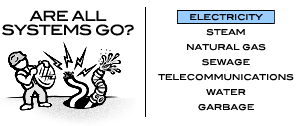There are several ways to look at electricity. The most obvious is in our homes, the 100 to 220 volts that turn on the lights, run the computers and the television, cool us down in the summer and (in many homes) allow us to cook our food. The least obvious is at the level of the atom: An electric current is created when a magnetic field causes the outer electrons of an atom to escape.
 Other articles in this series:
|
Another way is to look at the tall stacks of Keyspan's Ravenswood Power Station in Astoria sending out billowing plumes of steam and gas, a power plant that has been a major source of New York City's electricity since its construction in 1965. The plant can produce 2,200 megawatts, which is approximately up 25 percent of what the entire city needs on its most demanding day during the summer -- known as peak load.
But most New Yorkers looked at electricity with a new awe during one 24-hour period in August. You can make all the electricity you want, but transmission is key, as much of the Northeast, including New York City, learned when it suffered through one of the worst blackouts in history on August 14. Two weeks later, a blackout put the brakes on London during rush hour, and on September 28, a blackout darkened much of Rome.
The key to effective transmission and distribution is the grid, a somewhat ambiguous term that refers to the branching maze of cables and wires both overhead and underground through which electricity moves.
The production of electricity involves transforming energy from one form to another. Some kind of mechanical energy is needed to turn the rotating blades of the turbines that create the magnetic field. In New York State, thanks to Niagara Falls, that mechanical energy is hydropower some 16 percent of the time. Nuclear energy is the source about 20 percent of the time. Most of the rest is provided by fossil fuel.
Since New York City uses so much electricity, it is required to produce 80 percent of its peak load within city boundaries, from plants like Ravenswood. The first step in creating electricity at Ravenswood involves burning fuel to heat water.
The burning of fuel -- Ravenswood uses only natural gas and sometimes oil -- creates 1,000-degree steam in Ravenswood's 11-story-high boilers. (Ravenswood used to burn coal, which is far more polluting than the fuels it now uses.)
That steam then turns the rotating blades of the turbines. The turbines hold magnets that rotate 60 times per second. The magnets are each surrounded by a cylinder wrapped with copper wire. Every turn of the magnet creates an electric current in the copper wire.
Despite advances, this whole process of producing electricity is not very efficient. Only one third of the coal used in electricity generation, for example, is actually delivered to customers as electricity. The remainder is used up in the process or wasted.
After the energy is generated, it must reach the places that need it. High-voltage wires are fed to a handful of substations in the city through five major lines.
From these main substations, electricity goes out via other cables (know as feeders) to 45 area substations covering a smaller area. It then travels through the grid to still smaller areas and finally, to individual homes and businesses.
"The grid is where all the electricity flows. Companies generate power onto the grid and consumers get power from the grid," said Timothy Logan of the New York City Environmental Justice Alliance, a grassroots environmental network.
Each small area in the grid has its own circuit breaker, says Chris Olert of Con Edison. "The reason for this is reliability, to isolate a problem within a couple of blocks."
The local grid is 89,000 miles of underground cables and 33,000 miles of overhead wires that deliver electricity to 3.1 million locations in the five boroughs and Westchester County. The upkeep of this local grid is Con Ed's responsibility.
The transmission route from the plant to the consumer is a process of reducing voltages, otherwise known as "stepping down." This is done by transformers. When electricity is sent out from a plant, it is at a voltage high enough to fry or melt any device -- the lines outside Ravenswood carry up to 345,000 volts. At each branch along the grid, the electricity is stepped-down a little more until it reaches the 100 to 220-volt level for household usage.
And we use more of it all the time. Con Edison estimates that, every year, electricity use will be two percent to three percent higher than it was in the previous year. The top ten days of electricity consumption have all occurred in the last three years.




